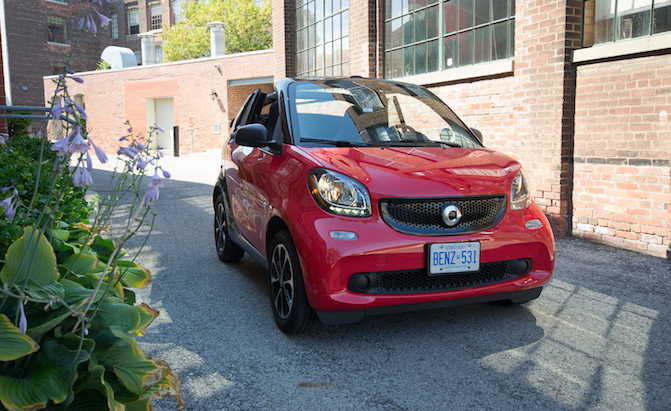Earlier this year, Daimler announced it would stop selling gasoline versions of the Smart ForTwo in North America, opting to only sell electric versions of the city car in the U.S. and Canada.
Before I spent a week in a red-on-black Smart ForTwo Cabriolet, I may have expressed some sympathy for the death of the 0.9-liter turbocharged version in North America. After all, I always found the ForTwo’s quirkiness to be endearing, and I think this third-generation car is actually pretty good looking for what it is. But I soon learned that the inbound electric version would solve my biggest gripe with the ForTwo, the powertrain, whilst keeping my favorite part, the size, fully intact.
Fastest Commuter in the City
Say what you will about cyclists, but in most major Metropolitan areas, bicycling helps people get around cheaply, quickly and sometimes even stylishly. Traffic is hardly a problem, as is parking, and being exposed to the elements can make you feel as if you’re going much faster than 15 mph.
Driving the ForTwo Cabriolet in the city is much the same.
With a big sedan or SUV (or most cars for that matter) driving in a busy area can be a bit of a burden – but not with the Smart. Navigating traffic is laughably easy. If you need to merge, most people let the little cabriolet in without thinking. I created my own parking spots and zipped down skinny alleys to avoid traffic. It’s the turning radius that is truly impressive, though. Sitting at just 22.8 feet, the ForTwo is waiting for you to bust a slick U-turn when you’re not supposed to. Believe it or not, this car manages to make city driving fun.
Powertrain Putdown
The ForTwo is in a league of its when it comes to urban mobility, then, but unless that comprises 90 percent of your time spent driving, you’d probably be best to stay away from the ForTwo – or at least this gasoline version. The 0.9-liter turbocharged three-cylinder is laggy, and when joined by the dimwitted six-speed twin-clutch automatic our tester had, its laziness is amplified. Smart tuned the traction control to be extra aggressive as well, which can add to the powertrain’s overall lack of urgency.
It’s not all bad, though. The three-cylinder pulls pretty well once you actually do get into the boost, and under wide open throttle, the twin-clutch shifts faster than it has any business doing so. When the sun’s shining and the top’s down, letting all 89 horsepower and 100 lb-ft of torque loose and using the manual shift option to bang through the gears can actually prove to be kind of fun.
That said, you won’t be wanting to do any sort of performance driving in the ForTwo. With rear drum brakes and loosely tuned suspension, it feels a bit skittish under heavy braking. It also pitches considerably through the corners and its heavily boosted city steering provides little feedback. I’m told this car is much more usable on the highways than its predecessor, but with attributes like these, I wouldn’t be doing too much driving over 70 mph. It’s also worth noting Smart suggests you use premium fuel with the three-pot, bringing the running costs up on a car that’s already a mildly pricey proposition.
A Cabin Fit for a Condo Dweller
The upscale, city-dwelling folk who may shop for the ForTwo should be impressed with the interior. Even though the entry-level Passion trim line of our tester lacked appointments like power mirrors and an infotainment screen, most of the materials were of decent quality for this segment and it all seemed bolted together rather nicely. We do have a couple complaints, however. The smartphone mount, which awkwardly plugs into the audio deck, is a bit chintzy and is surprisingly a $100 option on this touchscreen-less model. We could have done with a center armrest too, which is another $100 option, and the placement of the dash-mounted tach and clock is downright inconvenient.
SEE ALSO: 2017 Smart Fortwo Electric Drive Arrives this Summer with Cheaper Price
The Smart is fairly wide, measuring a whole 65.3 inches across, and proves to be spacious for two people as a result. There’s plenty of lateral room for both passengers, lots of space to move your seat backward and forward and large foot wells. Storage space is at a minimum, however, and with the engine mounted beneath the rear cargo area, trunk space is also scarce.
If you’re left wanting a bit more breathing room, you can always let the power folding roof back. It can be opened partially like a sunroof or fully retracted and if you’re feeling ambitious, you can remove the roof rails and store them in a neatly designed compartment in the hatch for a true open-roof experience. The roof rails need to be on for you to close the roof, though, so this will prove to be a rarely used feature for most.
The Verdict: 2017 Smart ForTwo Cabriolet Review
The Smart ForTwo is a car that makes perfect sense in Europe’s tiny city centers and in some of North America’s more compact Metropolises. Its combination of usability and maneuverability makes it a surprising delight to drive on tight busy roads, but it’s ultimately brought down by a laggy powertrain and skittish highway performance. Many North American consumers will find themselves happier with a more conventional offering like the Fiat 500, Ford Fiesta or Chevrolet Spark.
Smart’s now only selling the ForTwo Electric Drive here, which does away with the crude powertrain in favor of a zippy 80 horsepower electric motor fed by a 17 kWh battery pack. With the same maneuverability and a more responsive engine (and without the crude transmission), the ForTwo Electric Drive should do away with most of this gasoline version’s largest pitfalls.



Leave a Reply